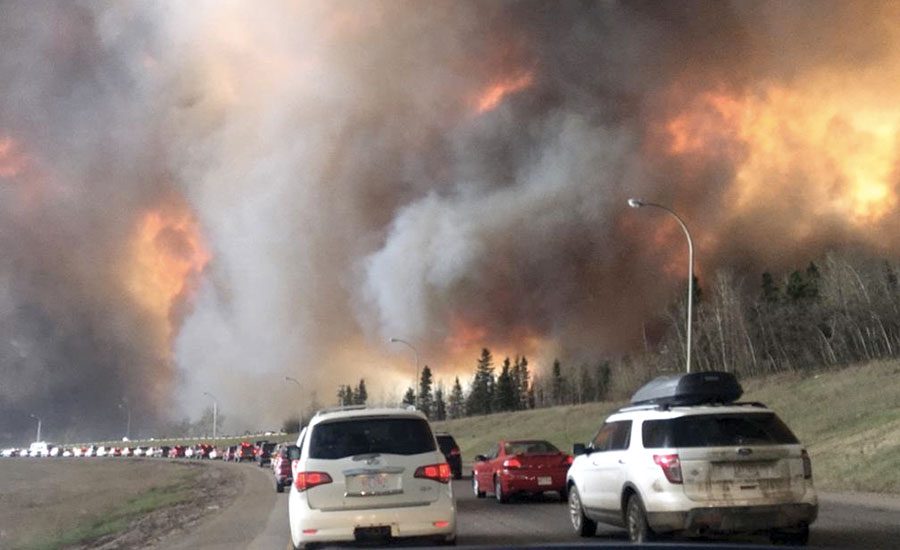SITUATION: Recent fire and flood disasters
In May 2016, the massive Fort McMurray wildfire that forced more than 80,000 people from their homes was dubbed the costliest disaster for insurers in Canadian history. With tens of thousands of personal, commercial and auto claims, the devastation took months to document and the re-build will be underway for some time to come.
Following closely on the heels of Fort Mac, in October 2016 the City of Windsor declared a State of Emergency when they were hit with record levels of precipitation. According to Environment Canada, the region saw a new single-day rainfall record set at Windsor Airport where the weather station measured 63.4 millimeters (about 2.5 inches), drowning the previous record set in 1973.
While most people were evacuating homes and leaving Fort Mac or steering clear of the flooding in Windsor, restoration contractors were on the ground immediately, working the front lines to document and file claims that would lead to the rebuilding and cleanup operations.
CHALLENGE: A lack of technology
The insurance ecosystem has historically been underserved by technology, relying on manual processes and complicated systems to address field inspections and claims. With inadequate systems in place, documenting a flood or fire that reaches the scale of a catastrophe is extremely overwhelming. Working through multiple claims at once is very time consuming, leading to inaccuracies, returned reports and extensive back and forth.
After long days on site inspecting and documenting the loss, claims still require additional administrative time in order to be finalized. This contributes to long cycle times as well as challenges organizing and cataloguing information. Keeping everyone up to date throughout the process is nearly impossible.
SOLUTIONS: Relieving the administrative burden
Amidst the chaos in both of these CAT situations, many restoration contractors found using technology that was easy to adopt simplified their processes and was able to transform their efficiency. Managing and documenting claims following the flood in Windsor, Foley Restoration was also able to transform their productivity.
“While contractors using older systems were struggling to keep up with all the activity during the flood, we were able to move really fast - documenting the claim and submitting the report in as quickly as 20 minutes. This allowed us to save a huge amount of time and helped to cut down on the administrative overhead that used to add hours to finalizing every claim,” said Brennan Foley of Foley Restoration.
Quality reporting can happen in real time
Another critical benefit the teams were able to experience with inspection technology was the increased level of quality in their reporting. Despite being in the midst of a CAT, teams were able to create incredibly high quality reports in half the time of their old legacy systems. Using a product called Encircle, WINMAR Toronto/Brampton was able to create reports containing pages of photos, photo notes and videos. This provided comprehensive reviews that were easy for insurance adjusters and reviewers to follow – like watching a story unfold.
“In a chaotic cat environment like the Windsor flood, we were able to move quickly while staying organized. Having visibility into all the work happening and being able to share information with all the players in real time was a huge advantage for us. It really elevated us in the eyes of the insurer and the policyholder,” commented Jad Stammers of WINMAR® Toronto/Brampton about responding to all the flood claims in their area.
Technology translates into true collaboration
The biggest benefits that the right field technology provided to the teams during the fire and flood were the levels of visibility and collaboration despite the challenging circumstances.
Software that can be used by everyone in house and in the field can be beneficial during any loss, but was especially beneficial during these recent disasters.
“All of our paperwork is instantly in the file and the field teams can see what is going on at the job before going out, “commented Sparklean DKI’s Christina Davis. “In Fort Mac, we were able to communicate and manage our jobs more efficiently. Much better than the paper processes before.”
CONCLUSION: Real-time collaboration equals transparency, reduced timelines, & less admin burden
The teams in Fort Mac and Windsor quickly discovered that with the right technology even a catastrophe was more manageable. Stephane de Caen, owner of Paul Davis Simcoe County, emphasized the importance of putting field documentation into full action from the start. Because it can be so easy to learn and adopt, she says “the intuitive nature of the software allowed all personnel from techs to project managers immediate use and saved us time and money handling this CAT.”
Hundreds of contractors are leading the industry in their use of technology during catastrophe losses and normal operations - experiencing first-hand the value of real-time collaboration. The results have allowed them to reduce administration and timelines by more than half. Perhaps the greatest benefit for all has been the transparent workflow that allows all players across the insurance ecosystem to have visibility and trust in the documentation. With their field documentation requirements streamlined, restoration contractors are able focus on the important work of rebuilding and restoring these communities.






Report Abusive Comment